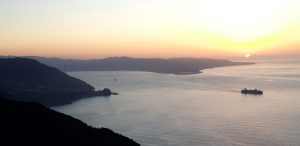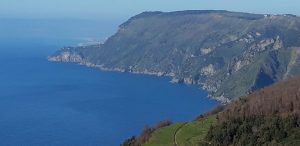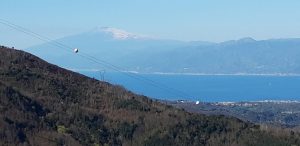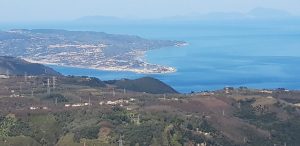The two watch points are located on the Tyrrhenian side of the Aspromonte National Park, in the Province of Reggio Calabria. Each takes its name from the closest town. The “Piciò” post is on the coast, at 470 m a.s.l., in the Municipality of Bagnara Calabra, while the “Solano” post is on the edge of the Piani d’Aspromonte, at 1006 m a.s.l., in the Municipality of Scilla.
In both cases, the environment is quite varied, mostly with alternating pastures and wooded areas, shrubs and cultivated areas, with typical Mediterranean scrub in Piciò and pine and gorse in Solano.


Views from Piciò: sunset over the Strait and the beautiful Costa Viola.
From both sites one can enjoy a magnificent view over the Strait of Messina and the Aeolian Islands. In addition, Scilla and the Costa Viola are visibile from Piciò, while the entire chain of the Peloritani Mountains and Mount Etna can be seen from Solano.
Each year, most birds of prey are observed at great distances from the watch points, but many fly at close range as well, particularly in Piciò. Therefore, there is no lack of opportunities to make beautiful observations, take wildlife photographs and to enjoy the spectacle of migration to the fullest. In March and April bird of prey counts are higher in Piciò than in Solano, in particular of species such as booted eagle, black kite, marsh harrier, osprey, sparrowhawk and buzzard, which reach peak migration in that period. In May, honey buzzards in Solano far outnumber all others with several thousand individuals seen.


Mount Etna and the Aeolian Islands from Solano.
Every year, from both locations there are sightings of rare birds of prey such as Egyptian vulture, griffon, lesser spotted eagle, imperial eagle, and lanner falcon. Local birds of prey that can be seen frequently are goshawk, golden eagle, and peregrine falcon. Over the years there have also been reports of super-rarities such as steppe eagle, Bonelli’s eagle, and Oriental honey buzzard.
The migration of storks, bee-eaters, swifts, Hirundinidae and other passerines between mid-April and early May is sometimes spectacular, especiallyi n Piciò. From this watch point it is often possible to see seabirds and bottlenose dolphins.
The bird species checklist is rich for both locations, and in addition to many birds of prey it includes nesting Passerines such as the red-backed shrike and Dartford warbler, species of conservation interest.
The entomological fauna, especially the lepidopterological one, is very diversified and interesting, with over 30 species of diurnal butterflies observed in each location.